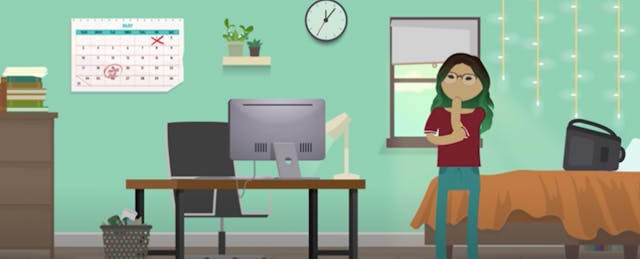When college students don’t understand what the professor is talking about in class, they often do what most anyone these days would do—search Google or YouTube for answers. That may be happening even more now that so much college teaching has moved online during the COVID-19 pandemic.
YouTube is full of answers presented in very different styles than traditional professors use. In fact, there’s a community of “EduTubers,” people supported or encouraged by YouTube, who make a living as independent educators, creating short videos on a range of academic subjects.
Now, one of the largest colleges in the U.S., Arizona State University, has teamed up with one of the most popular educational YouTube channels, Crash Course, to jointly develop a series of videos designed to help college students in subjects that are harder to find on free sites. Called Study Hall, the new series will feature new episodes every Tuesday, starting with a course on writing composition.
Crash Course is the creation of brothers John and Hank Green, who started the YouTube channel in 2012. They had no formal training as teachers, and have developed a fast-paced and irreverent style. The effort has expanded over the years, as the two have brought on new hosts and grown the collection to more than 1,200 videos on a range of topics, many aimed at the high school level.
Both brothers are also bestselling writers of novels for young adults, and John Green’s book, “The Fault in Our Stars,” was turned into a Hollywood film.
“We don’t want people to feel like learning is a series of hurdles that have been placed in front of them in order to receive a diploma,” said John Green, in an interview with EdSurge. Instead, he hopes viewers will see learning as “a way to understand ourselves and our place in the universe—and that’s fun and that’s exciting.”
The collaboration germinated at an EduCon conference organized by YouTube, where the Green brothers talked informally with Sean Hobson, chief design officer of ASU’s online-learning arm, EdPlus, and came up with the idea.
Other colleges had talked to Crash Course about a possible partnership as well, said Green. But he liked ASU’s focus on reaching a broad range of students and making college more accessible. As he put it, ASU is asking “who can we make part of the story of postsecondary education, instead of how we can be the most elite, lowest-acceptance-rate college in the world.”
And Crash Course had been interested in making more work aimed at the college level, and on complex topics not well served by other EduTubers because there might not be as broad an audience for them, Green added.
Student Hosts
Under the arrangement, folks from Crash Course are working directly with ASU professors to plan and produce videos in four subject areas—writing composition, algebra, chemistry and data literacy. But that doesn’t mean the professors necessarily appear on screen. In one of the first Study Hall videos, the host is an ASU undergraduate, Yumna Samie.
“Part of the recipe that the Crash Course team has gotten so right is making sure you’re relatable to the person on the screen,” said Hobson. They “design videos that really get to the point of solving a problem and are very relatable,” added. “We’re choosing a host that aligns with those principles,” and who might not always be a faculty member.
Some education research has shown that even the best-made videos—or even excellent lectures in person—do little to help students learn, and that the best learning comes from the students engaging with material themselves.
That’s a sentiment leaders of the Study Hall effort don’t dispute, and they stress that the videos are not intended to replace professors or teachers.
“In isolation, nothing works,” said Green. He added that the videos he helps make—and any other educational strategy—“has to work in concert with other things.”
Officials declined to share details about the costs involved in the effort, or to say who is paying for what. “We’re sharing a lot of the risks,” said Hobson. “We’ll see where these can go with these first couple of playlists.”
The project was planned before the outbreak of the COVID-19 virus that has shut down schools and colleges around the world and shifted classes online. But the new educational videos might find an even larger audience now that so many instructors are looking for videos to assign, and so many students are adapting to learning online.
“We’re definitely seeing an uptick in the number of people seeking out Crash Course videos, especially high school and college students that are seeking it out,” said Green. “Really we just hope that during a time that’s very difficult for everyone, it can be a resource that’s reliable and accessible and helpful. But it’s just one resource among many.”


